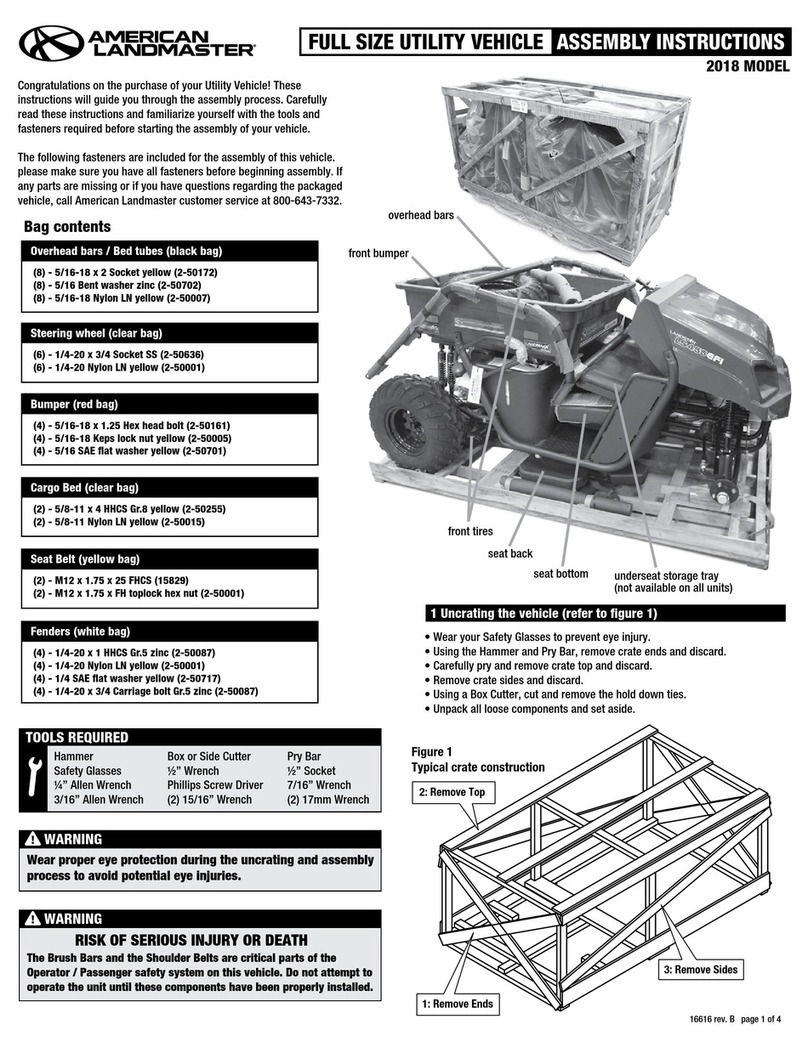
9
16599 rev. B pub. 11/07/2017
section 2 safety
• Use extreme caution when descending hills or running on loose
slippery surfaces. Towing, braking, and traction are greatly diminished.
• Do not operate vehicle on 15 degree (26% grade) slopes or steeper.
• Avoid changing direction or making sharp steering corrections on
slopes or rollover may occur.
• If this vehicle begins to tip when crossing a slope, turn the front wheels
downhill to regain stability and control.
• Never allow vehicle to coast or free wheel in neutral or loss of control
may result.
• When crossing a slope on soft terrain, turn the front wheels slightly
uphill and maintain a constant speed to maintain a straight line of travel.
• When descending hills or slopes apply steady pressure to the foot
brake to avoid potential of freewheeling or runaway.
• If your vehicle loses power and stops while climbing a hill, immediately
engage the foot brake and back slowly down the hill maintaining
a straight downhill line of travel. Do not attempt to turn the vehicle
sideways on the hill or a rollover could result.
• When traveling at night always use your headlights and reduce speed
according to visibility, trail, and terrain conditions.
• Avoid water crossings when possible and never cross a body of
water where depth is unknown. Loss of power will occur if the drive
belt becomes submerged or wet. Unnecessary crossing of streams and
waterways erodes shore line and damages water-born habitat. If you
must cross, do it at a point where banks are not steep and proceed at a
slow and steady speed.
• Front bumper and brush guards are not designed as push bars. Do not
attempt to push other vehicles or implements or damage may result.
• Do not shift transaxle unless this vehicle is fully stopped and the
engine is at idle or damage may occur.
• This vehicle is not designed for use on rental tracks of any kind.
• The safe operation of this vehicle is dependent upon the operator’s
ability to exercise proper judgment.
a. Operator and passenger must not be too small or too large for
controlled operation.
b. Operator and passenger must be of sufficient age, understanding,
mental capacity, and physical capacity to safely operate and
ride in the vehicle.
c. Vehicle should only be operated after mature, supervised
instruction and sufficient practice in an un-congested area.
• NEVER start the engine without checking to see that the throttle
control is in idle position.
• ALWAYS use extreme caution when starting the engine.
a. Hot engine, muffler, shield, or drive components can burn on
contact.
• ALWAYS use extreme caution when starting the engine.
a. Hot engine, muffler, or drive components can burn on contact.
• NEVER operate the machine while under the influence of alcohol,
drugs, or medication of any kind.
a. Such operation is dangerous to yourself and/or others.
• NEVER use hand held electronic devices while driving this vehicle.
a. Driving while distracted can result in loss of vehicle control,
accident and injury.
• Wet, slippery, rough, or sloped terrain is potentially dangerous and may
result in injury if proper caution is not observed.
a. ALWAYS SLOW DOWN
b. Operator must use mature judgment, skill, and experience to
choose a speed suitable for terrain and riding conditions in
protecting operator, passenger, and/or any bystanders.
c. Operator must use mature judgment, skill and experience in
choosing suitable terrain for individual operational capabilities.
• ALWAYS SLOW DOWN when turning.
a. This vehicle is not a passenger car. High-speed turning and
failure to operate this vehicle correctly may cause loss of
control, vehicle rollover and/or possible death or injury to the
vehicle occupant(s).
b. Turning on a slope increases the risk of rollover.
c. Practice driving in a safe open area to develop a feel for the
vehicles performance and handling characteristics, size and weight.
• When turning on pavement, loose gravel, or similar surfaces, there is
an increased risk in loss of control. ** ALWAYS SLOW DOWN! **
• Operating the vehicle in conditions where water, mud, snow, dirt, sand,
or other debris can get into the throttle cable conduit and/or on the
throttle mechanism may cause binding of the cable and/or the throttle
mechanism.
a. This may result in the throttle sticking which can cause the engine
to continue to run and result in loss of control.
• STOP the vehicle and back slowly down any hill that the vehicle lacks
the power or traction to climb. Do NOT turn across the slope or try to
turn around.
a. Turning on a slope increases the risk of rollover.
b. Control the descent speed with the brake (left foot pedal).
c. Re-applying the throttle when facing up a steep hill increases the
risk of the front tires leaving the ground and the vehicle over-turning.
• STOP the engine if the machine makes unusual noises or vibrations.
a. Check the vehicle for damage.
b. Excessive noise or vibration is a sign of loose or worn parts.
c. Do not attempt to use the vehicle until it has been serviced to correct
the issue.
• Secure all cargo and loads with proper tie-downs.
• Always put the vehicle in neutral and set the parking brake when
unattended.
• The vehicle is NOT to be operated by anyone under 16 years
of age.
• Keep hands, feet, and all body parts in the vehicle at all times.
WARNING WARNING
OPERATION OPERATION
UNDER
AGE
16




























